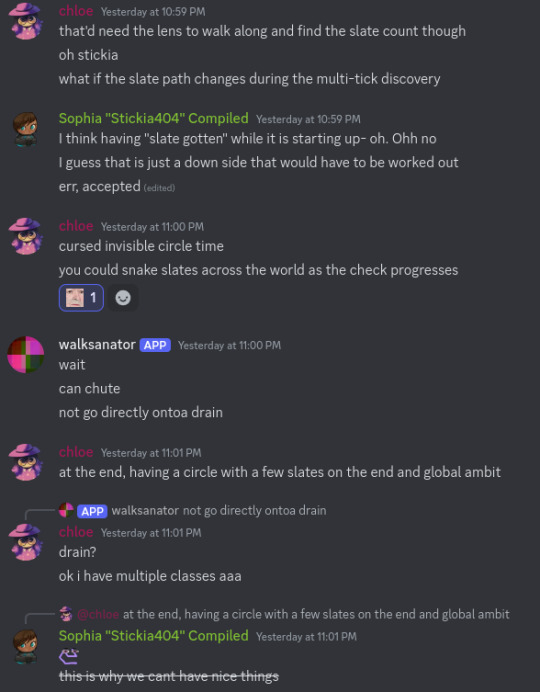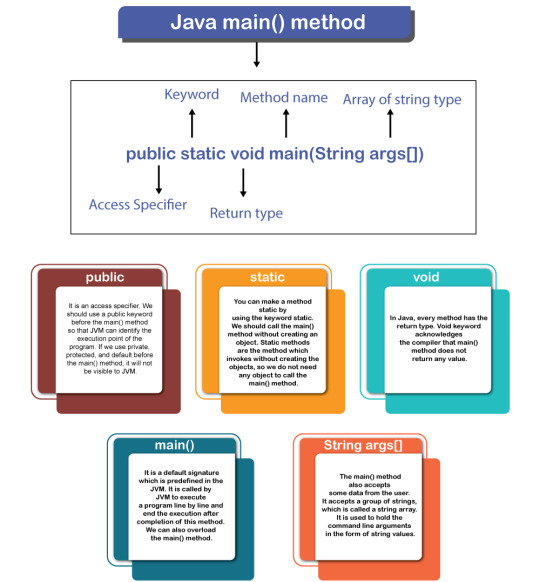#Java online
Explore tagged Tumblr posts
Text
Java is a programming language and computing platform first released by Sun Microsystems in 1995. It is a class-based, object-oriented language that is designed to be portable, meaning that Java code can run on a wide variety of hardware and operating systems. Java is widely used to develop enterprise-level applications, mobile apps, video games, and other types of software.
0 notes
Text
"We do what we must, because we can"
Whenever you get an idea, you must ask your self some questions: is this possible? How long would it take? Is it worth it? Should I even do this? However, some ideas politely ignore all of these questions and go straight into action.
Introducing the World Slate:




World Slate, The Great Work, Ghost-Circle, "Sophia why the fuck did you even think of making this," whatever you call it; it is a massive Spell Circle that is approximately 11 thousand blocks by 12 thousand blocks large. This covers about 30% of the overworld of the HexxyTest server.
For those who don't know Spell Circle Tech: a Spell Circle calculates ambit based on how big it could be, rather than based on where it does runs. So you can "trick" a Spell Circle into having a massive ambit by having a looping system that connects to outer "prongs" via a directrix. This is how the World Slate has complete ambit over 30% of the whole overworld. However, there is a large problem, lag.
Spell circles (shouldn't) gain lag while running; since they now, in 1.20, run each pattern while going over them. On the other hand, during a start-up a Spell Circle needs to calculate what slate it can run on, caching it into its NBT data. This seems like it could be a large source of lag, since it's doing a flood fill over possibly thousands of blocks; but, that is only half true. If all the slate blocks are in the same loaded area, the flood fill only takes a few milliseconds, barely anything. But, to get the block data to find where the slate could go, it has to load the chunk the slate in, which is not that bad, IF the slate does not go across ~1400 chunks. Loading, and calculating, that many chunks will lag a server badly (maybe even kill it); so the project seems hopeless.
But, there is a way to fix the lag of loading ~1400 chunks in less than a tick, optimizations.
Since I know Java and some bits about modding, I have been trying to fix some more laggy parts of Spell Circles. I have already fixed a moderate lag source of looping Spell Circles (chunk bans are fun!). So it hypothetically shouldn't be too hard to somehow optimize Slate Discovery.
There are 2 large problems with optimizing Slate Discovery though: How to locate them, and how to store the found slate. The 2nd problem is much easier to solve, rather than storing them in a set of raw Vec3s like it does now, it would be best to compress them down (maybe into a string representation or something) then uncompresses them when it is running. This could be done with a small, quick compression algorithm.

However, optimizing the finding of the slate is another problem. The best system would be finding the slate without loading the chunks, but this is impossible, so we need to use a 2nd method.
That 2nd method would be to break up slate discovery over time, so instead of loading ~1400 chunk all at once, we can just load 200 chunks each tick until we get all ~1400 chunks. This system does have some minor problems, and a big problem. The small problems would be: how to keep discovery going if the server closes, how would you serialize the discovery list, how would you tell the impetus to look over time, etc. And these problems are simple enough; however, the big kicker is that the player could move slate during discovery.

As said by Chloe, people could move the slates in discovery, meaning they could cheat the system by moving the slates while they are being scanned, and still get "world ambit" for about fre. This is, unfortunately, just a problem that would have to be accepted for a system like this.
I do think that flaw can be somewhat ignored though. Since, if you are willing to make a Hex (or a massive contraption) that works every tick to move earth-shattering amounts of slate; then you can have world ambit fuck it.
Or you know, instead of doing this whole massive problem if optimizing slate scanning just do something like re-adding the slate limit
However, if you have any ideas of how Slate Discovery could be optimized; or if I am insane for starting this project; please let me know.
#hex casting#long post#hexcasting#World Slate#HexxyTest#HexxyCraft#Modded Minecraft#minecraft build#coding#java#also#OG use of this was just to have free teleportation and to remove all phantoms from the world#I did not make an EoS on purpose#(EoS is Eye of Sauron; or getting all the truenames of players online)#Holy Fuck#This borderline essay is about 700+ words#all the images also have descriptions!#also also#please skim through this#I am really proud of all of this
20 notes
·
View notes
Text



got this little dude yesterday, he was 50% off because of the growth (tumor?) on his eye
#feel free to suggest names<3#also got a couple of java ferns#i was gonna get a betta mahachaiensis for this tank but decided i didn't want to order a fish online in the middle of winter#betta#betta fish#fishblr#aquarium#aquariums#planted tank#fish tank#fish#plantblr#bettablr#mine
23 notes
·
View notes
Text
me: okay cool so minecraft stores your skins digitally now so it should be easy to find and download my skin to edit it
minecraft launcher: good news! we made everything more user friendly so you don't have to hunt down the folder we store your skin in anymore to change it :)
me: okay but i can still get to that folder right
minecraft launcher: :)
me: or at least let me download the file that *I* put there, right
minecraft launcher: :)
#i know i KNOW i'm a bad gamer i never backed up my harddrive on my old PC before it crashed#I DID save back up a few important files (most of my PC was a mess anyway) but idk where tf i put my minecraft skin#Like i can SEE it walkin around the screen with all the steves on it but i guess i can't get the actual FILE cause it's stored online now#Grrrrrrr#mine#minecraft#minecraft java
15 notes
·
View notes
Text

How to Learn Java Step by Step: Core Concepts
Java is one of the most popular programming languages used by over 9 million developers worldwide. Learning Java opens up opportunities across many industry verticals. This section provides an overview of Java, reasons to learn it, and the key concepts you'll need to know to get started.
14 notes
·
View notes
Text
May 2025 Game Recap
Games Played:
Minecraft: Bedrock Edition
Minecraft: Java Edition
NERTS! Online
Murder Miners
Half-Life
4D Minesweeper
The Evil Within
The Forest
Paladins
#game journal#may game recap#game recap#may#may 2025#may 2025 game recap#minecraft: bedrock edition#🤮#minecraft: java edition#nerts! online#murder miners#half-life#half life#half life 1#4d minesweeper#the evil within#the forest#paladins
2 notes
·
View notes
Text
looking for moots
in desperate need of online friends ! dm me pretty please ii play new club penguin and animal jam play wild, star stable online, my singing monsters, roblox, minecraft bedrock and java, and stardew valley!
#autism#therian#otherkin#sfw age regression#star stable online#my singing monsters#club penguin#animal jam#stardew valley#animal jam play wild#roblox#minecraft#minecraft java#minecraft bedrock#looking for friends#looking for moots#mutuals#age regressor#dm me#my little pony#bluey
12 notes
·
View notes
Text
youtube
#online courses#coding#graphic designing#web design#ict skills#india#hindi#gujarati#english#www.ictskills.in#online training#live training#full stack course#digital marketing#ui ux design#backend#online#live courses#courses#education#computer science#engineering#java#python#php#dot net development company#spring mvc#javascript#Youtube
2 notes
·
View notes
Text
2 notes
·
View notes
Text
Java main() method
Let us see the description of Java main() method:

#java#programming#javaprogramming#code#coding#engineering#computer#computerscience#computertechnology#software#softwaredevelopment#education#technology#main#method#online
3 notes
·
View notes
Text
i need to play minecraft with my friends or ill explode
#i havent gotten to play in forever#but also switch online costs money.....#and so does a realm because i cant play java at all.......#ugh
6 notes
·
View notes
Text

Albert Buell Lewis (1867-1940), Javanese Batik Designs from Metal Stamps, Chicago, Field Museum of Natural History, Anthropology of Design Series, no. 2, 1924.
Digitized for the Biodiversity Heritage Library.
13 notes
·
View notes
Text
Introduction To programming with Python
Why learning Python is beneficial for students?:
Beginner-Friendly Syntax
Versatility
Large Community and Resources
High Demand in Job Market
Why choose Skill-Full Developer for learning Python?
100% Placement Guarantee : We offer a 100% placement guarantee. If a student doesn't secure a job after completing our Python training program, we will refund the full amount. This commitment ensures that students can trust our training quality and our dedication to their success.
Experienced and Skilled Developers : Our trainers are highly skilled and experienced developers who bring real-world expertise. This ensures that students receive practical and relevant training, preparing them to excel in the job market.
Comprehensive Curriculum : Our Python training program covers all essential topics, from basic syntax to advanced concepts like data science and machine learning. This comprehensive approach equips students with the knowledge and skills needed to tackle diverse projects and roles.
Hands-On Learning and Projects : We emphasize hands-on learning with real-world projects and assignments. This practical experience helps students build a strong portfolio, making them more attractive to potential employers and better prepared for industry challenges
For more information visit our website:
https://skillfulldeveloper.com/course/python
2 notes
·
View notes
Text

the new tank is fully cycled! time to get a couple more plants and a betta!!
#tbh i've been looking at it so much that i can't tell of i actuallt like it aesthetically but it'll do#i think im just gonna get a couple java ferns for the background#im Hoping to get a betta mahachaiensis online but we'll see if the weather cooperates for shipping#also happy new year !!#planted tank#aquarium#planted aquarium#aquariumblr#fish#fishblr#fish tank#mine
11 notes
·
View notes
Text
Understanding Object-Oriented Programming and OOPs Concepts in Java
Object-oriented programming (OOP) is a paradigm that has revolutionized software development by organizing code around the concept of objects. Java, a widely used programming language, embraces the principles of OOP to provide a robust and flexible platform for developing scalable and maintainable applications. In this article, we will delve into the fundamental concepts of Object-Oriented Programming and explore how they are implemented in Java.

Object-Oriented Programming:
At its core, Object-Oriented Programming is centered on the idea of encapsulating data and behavior into objects. An object is a self-contained unit that represents a real-world entity, combining data and the operations that can be performed on that data. This approach enhances code modularity, and reusability, and makes it easier to understand and maintain.
Four Pillars of Object-Oriented Programming:
Encapsulation: Encapsulation involves bundling data (attributes) and methods (functions) that operate on the data within a single unit, i.e., an object. This encapsulation shields the internal implementation details from the outside world, promoting information hiding and reducing complexity.
Abstraction: Abstraction is the process of simplifying complex systems by modeling classes based on essential properties. In Java, abstraction is achieved through abstract classes and interfaces. Abstract classes define common characteristics for a group of related classes, while interfaces declare a set of methods that must be implemented by the classes that implement the interface.
Inheritance: Inheritance is a mechanism that allows a new class (subclass or derived class) to inherit properties and behaviors of an existing class (superclass or base class). This promotes code reuse and establishes a hierarchy, facilitating the creation of specialized classes while maintaining a common base.
Polymorphism: Polymorphism allows objects of different types to be treated as objects of a common type. This is achieved through method overloading and method overriding. Method overloading involves defining multiple methods with the same name but different parameters within a class, while method overriding allows a subclass to provide a specific implementation of a method that is already defined in its superclass.
Java Implementation of OOP Concepts:
Classes and Objects: In Java, a class is a blueprint for creating objects. It defines the attributes and methods that the objects of the class will have. Objects are instances of classes, and each object has its own set of attributes and methods. Classes in Java encapsulate data and behavior, fostering the principles of encapsulation and abstraction.
Abstraction in Java: Abstraction in Java is achieved through abstract classes and interfaces. Abstract classes can have abstract methods (methods without a body) that must be implemented by their subclasses. Interfaces declare a set of methods that must be implemented by any class that implements the interface, promoting a higher level of abstraction.
Inheritance in Java: Java supports single and multiple inheritances through classes and interfaces. Subclasses in Java can inherit attributes and methods from a superclass using the extends keyword for classes and the implements keyword for interfaces. Inheritance enhances code reuse and allows the creation of specialized classes while maintaining a common base.
Polymorphism in Java: Polymorphism in Java is manifested through method overloading and overriding. Method overloading allows a class to define multiple methods with the same name but different parameters. Method overriding occurs when a subclass provides a specific implementation for a method that is already defined in its superclass. This enables the use of a common interface for different types of objects.
Final Thoughts:
Object-oriented programming and its concepts form the foundation of modern software development. Java, with its robust support for OOP, empowers developers to create scalable, modular, and maintainable applications. Understanding the principles of encapsulation, abstraction, inheritance, and polymorphism is crucial for harnessing the full potential of OOPs concepts in Java. As you continue your journey in software development, a solid grasp of these concepts will be invaluable in designing efficient and effective solutions.
#javascript#javaprogramming#java online training#oops concepts in java#object oriented programming#education#technology#study blog#software#it#object oriented ontology#java course
3 notes
·
View notes
Text
Navigating Java's Promising Future: A Closer Look at the Ever-Expanding Horizons of Technology
In the fast-paced world of technology, Java stands tall as a resilient language with boundless potential. Its enduring significance and robust ecosystem position it as a cornerstone of software development across various domains. Let's explore the myriad factors that contribute to Java's promising trajectory in the evolving landscape of technology.

1. Unmatched Versatility and Reach
Java's versatility knows no bounds, making it a preferred choice for developers across diverse industries. From web and mobile app development to enterprise solutions and big data processing, Java's adaptability ensures a wide spectrum of career opportunities. Its widespread adoption and proven track record make it a dependable foundation for building scalable and resilient applications.
2. Thriving Ecosystem and Community Support
At the core of Java's success lies its thriving ecosystem and vibrant community. With a vast array of libraries, frameworks, and tools, the Java ecosystem empowers developers to streamline development processes and create cutting-edge solutions. Furthermore, the active Java community fosters collaboration and innovation, driving the language's evolution to new heights.
3. Platform Agnosticism
Java's renowned "write once, run anywhere" principle remains a key advantage in today's multi-platform landscape. Developers can craft Java applications that seamlessly operate across different platforms and devices, ensuring interoperability and accessibility. This platform-agnostic approach simplifies development efforts and broadens the reach of Java-powered solutions.
4. Dominance in Enterprise Solutions
Java continues to maintain its stronghold in the enterprise sector, powering critical systems for numerous Fortune 500 companies. Its reliability, scalability, and robust security features make it the preferred choice for building large-scale enterprise applications. As businesses increasingly rely on digital solutions, the demand for skilled Java developers remains steadfast, offering lucrative prospects in corporate environments.

5. Seamless Integration with Emerging Technologies
Java's adaptability extends to emerging technologies such as cloud computing, artificial intelligence, machine learning, and the Internet of Things (IoT). Leveraging Java's robust frameworks and libraries, developers can innovate and build solutions that harness the potential of these cutting-edge technologies. Java's compatibility with emerging trends ensures its relevance and longevity in a rapidly evolving tech landscape.
6. Continuous Evolution and Enhancement
The Java platform undergoes continual evolution to stay at the forefront of industry trends and technological advancements. With each new release, such as Java 15 and beyond, developers gain access to enhanced features, improved performance, and strengthened security measures. Java's commitment to innovation ensures its competitiveness and relevance in the dynamic software development sphere.
7. Focus on Performance Optimization
Performance optimization remains a top priority for Java developers, driving efforts to enhance the language's efficiency and speed. Through bytecode enhancements, garbage collection improvements, and runtime optimizations, Java delivers exceptional performance in diverse computing environments. This relentless focus on performance ensures that Java remains a top choice for resource-intensive applications.
8. Accessibility and Education Initiatives
Java's popularity extends beyond professional development, making it a cornerstone in educational institutions and training programs worldwide. Abundant resources, tutorials, and online courses enable aspiring developers to learn Java and embark on rewarding careers in software development. Java's widespread use in academia fosters a steady influx of new talent, enriching the industry with fresh perspectives and ideas.
In summary, Java's future looks promising, driven by its unparalleled versatility, robust ecosystem, enterprise dominance, integration with emerging technologies, continuous evolution, performance optimization, and accessibility initiatives. As Java continues to adapt and innovate, it will remain a vital force in software development for years to come.
2 notes
·
View notes